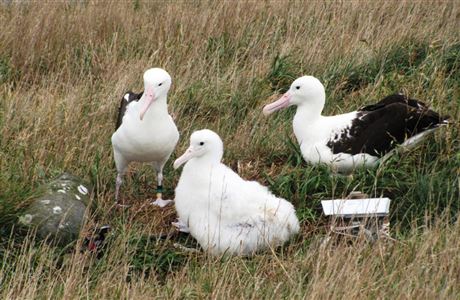Albatross chick needs a name
Archived content: This media release was accurate on the date of publication.
Introduction
The albatross chick at Pukekura/Taiaroa Head which has become an internet sensation will soon have a name.Date: 10 May 2016
Thousands of people throughout the world have been watching the Northern royal albatross/toroa chick at the albatross colony at Taiaroa Head on Otago Peninsula on a web cam since it hatched in January. Now the DOC is asking for names for him (or her). The gender of the chick cannot yet be determined.
Announcing the launch of the online naming competition today, DOC's threatened species ambassador Nicola Toki said the public could submit name ideas until May 27. "Because viewers have taken such ownership of this chick, we thought it only right they should have the opportunity to give it a name."
"We're looking for a name that reflects the characteristics of the species or their habitat on Otago Peninsula and their importance as a taonga species," Nicola said.
"We're grateful to our supporters, particularly Air New Zealand, for contributing to this competition."
Te Poari a Pukekura (the Pukekura Co-management Trust) will choose the top five names and the final winning name will be decided by public vote and announced on 21 June. The winner will receive a trip for two to Otago Peninsula to meet the royal cam chick.
Background information
Since the chick hatched in January, the royal cam webpage has received 232,963 views and 5921 comments. The cam has received 254,814 views on YouTube. This equates to 4,903,005 minutes watched – that’s 9 years and 117 days. These numbers are increasing significantly every week.
We hope to film the chick until it fledges (is ready to fly), about September.
The chick is currently left alone on the nest for long periods while its parents are at sea foraging for food.
Northern royal albatross are a vulnerable species and an icon of Dunedin. They are a taonga species for Ngāi Tahu.
With a wing span of over three metres, Northern royal albatrosses are among the largest seabirds in the world.
After the chick fledges, its parents will leave the colony and spend the following year at sea. They then return to breed again, completing a two-year cycle.
The Royal Albatross Colony is the only mainland place in the world to view Northern royal albatross in their natural habitat. There are more than 150,000 visitors a year to the site.
DOC manages the Northern royal albatross colony with the support of the Otago Peninsula Trust, Te Poari a Pukekura (Pukekura Co-management Trust) and Dunedin City Council. The colony has benefited from decades of DOC’s management and predator control. It has grown from one breeding pair in 1937 to about 50 pairs in 2015. 10,000 seabirds are also thriving at Taiaroa Head, including nationally vulnerable and threatened species like red-billed gulls and Otago shags.
Contact
For media enquiries contact:
Email: media@doc.govt.nz



